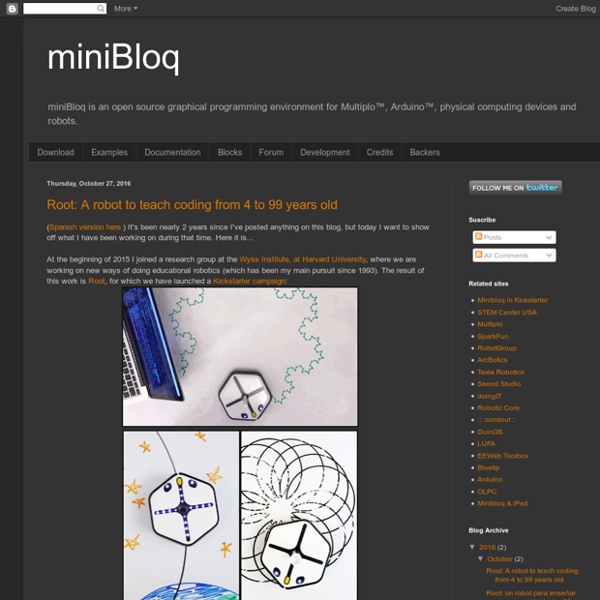



Labs - Index browse Got a Mega ADK in your hands and can’t wait to use it? Not interested in the project’s history? Visit the step by step tutorial and start playing with your Arduino board, Processing, and your Android device. This page gives background on Android’s Accessory Development Kit and the Arduino Mega ADK, which was designed to work with Android. Description The Arduino ADK is a combination of hardware and software designed to help people interested in designing accessories for Android devices. During Google’s 2011 IO keynote [1] , Google introduced a board [2] based on the Arduino Mega 2560 which includes this USB host. About the Mega ADK board The Mega ADK board is a derivative of the Arduino Mega 2560. Arduino Mega ADK board (note the board in the picture is a prototype) The USB host is not part of the original core of Arduino. There are three libraries needed to make the system work: The first two come bundled together into a single folder. Android Accessories: what are those? Android SDK Handbag
engenhocas4you Snap4Arduino beta GNU/Linux You just need to unpack the package. The executable is Snap4Arduino. In case it complains about a missing library, you can sudo run the postinstall.sh script, which will attempt to automatically take care of the issue. If you would like to help us build packages for different distros, please don't hesitate to write to us. MacOS X Unzip the package and run the Snap4Arduino package. Microsoft Windows Just unzip the package and run the installer. Chromebook Extract the experimental Chromebook package, a file called Snap4Arduino-chrome.crx will pop up Point your Chrome to (paste this in your address bar) Drag and drop the Snap4Arduino-chrome.crx file from your file system into your Chrome, into the tab Chrome will tell you the extension needs you ti give it permissions. Other systems The experimental Chrome app will (mostly) work on any other system.
BOSSA | shumatech.com BOSSA is a flash programming utility for Atmel's SAM family of flash-based ARM microcontrollers. The motivation behind BOSSA is to create a simple, easy-to-use, open source utility to replace Atmel's SAM-BA software. BOSSA is an acronym for Basic Open Source SAM-BA Application to reflect that goal. What's wrong with using SAM-BA? Well, there are several reasons to consider an alternative. The first reason is complexity. The second reason is expandability. The third reason is reliability. The fourth reason is portability. The last reason is size. BOSSA communicates with the SAM-BA boot loader running on the SAM device via either a RS-232 port connected to the SAM device's debug serial port or for SAM devices that support USB, over a USB CDC virtual serial port. BOSSA supports all of Atmel's known flash-based SAM devices but some specific devices and device families have not been tested. $ bossac -h Usage: bossac.exe [OPTION...] Windows Linux Mac OS X BOSSA Binaries BOSSA Source Code
UV LED PCB Exposure System This project shows the creation of a large array of UV LEDs. They are used to expose a presensititised blank circuit board. Another common method is to use UV tubes. bitbloq Open Accessory Development Kit The Accessory Development Kit (ADK) is a reference implementation for hardware manufacturers and hobbyists to use as a starting point for building accessories for Android. Each ADK release is provided with source code and hardware specifications to make the process of developing your own accessories easier. Creating new and alternative hardware based on the ADK is encouraged! Android accessories can be audio docking stations, exercise machines, personal medical testing devices, weather stations, or any other external hardware device that adds to the functionality of Android. Accessories use the Android Open Accessory (AOA) protocol to communicate with Android devices, over a USB cable or through a Bluetooth connection. If you are building an accessory that uses USB, make sure you understand how to implement the AOA protocol to establish communication between your accessory hardware and Android. ADK 2012 Guide Guide to getting started with the ADK released at Google I/O 2012. ADK 2011 Guide
Arduino Microcontroller Feature Comparison - GoRobotics Arduino is fast becoming one of the most popular microcontrollers used in robotics.There are many different types of Arduino microcontrollers which differ not only in design and features, but also in size and processing capabilities. In this article, you’ll understand the differences between the Arduino Microcontrollers (as of 2012). There are many features that are common to all Arduino boards, making them very versatile. There are many additional manufacturers who use the open-source schematics provided by Arduino to make their own boards (either identical to the original, or with variations to add to the functionality). Arduino Mini / Mini Lite The smallest Arduino product is the Arduino Mini Light which is a 24-pin microcontroller without any connectors soldered. The Mini and Mini lite are really intended to be used with breadboards. Arduino Pro Mini 3.3V / Pro Mini 5V The Arduino Pro Mini 8MHz and 16MHz are also breadboard mountable and are a bit longer than the Arduino Mini.
Code An App: Make Computers Do Something For You | Learn How To Program A Computer | Learn Computer Programming ArduinoExperts: Arduino Developers + Arduino Jobs Welcome